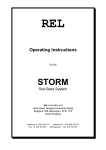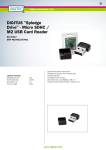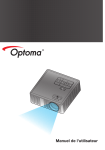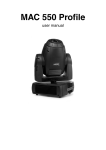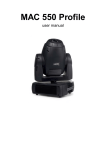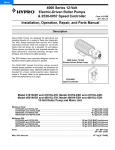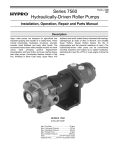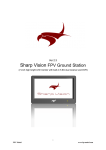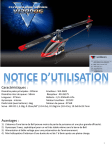Download IPCAM User`s Manual
Transcript
IPCAM User's Manual V 3.0.28 © Copyright 8th Dec. 201 20111 This manual contains proprietary information, protected by copyright. All rights reserved. IPCAM User's Manual Contents Contents................................................................................................................................................. 2 Safety Instructions................................................................................................................................. 4 Ⅰ Product Features..............................................................................................................................6 Ⅱ Product Application..........................................................................................................................6 Ⅲ Product Description......................................................................................................................... 9 3.1 Product Appearance Structure Description.................................................................................................. 9 3.2 Back Board Description............................................................................................................................... 10 3.3 Alarm I/O Wiring Description...................................................................................................................... 11 3.4 Installation Description............................................................................................................................... 12 Ⅳ Network Connections Topology Type............................................................................................ 13 4.1 Topology Type 1.......................................................................................................................................... 13 4.2 Topology Type2........................................................................................................................................... 13 4.3 Topology Type3........................................................................................................................................... 13 Ⅴ Client Software Installation and Instruction.................................................................................. 14 Ⅵ Web Client Navigation................................................................................................................... 14 6.1 System Requirements..................................................................................................................................14 6.2 Connection Access HD IP Camera................................................................................................................14 6.3 Web Client Function Navigation..................................................................................................................18 Ⅶ Web Client Operation Details........................................................................................................ 20 7.1 Live Video.................................................................................................................................................... 20 7.2 Image Setting...............................................................................................................................................21 7.2.1 Basic Parameter...............................................................................................................................21 7.2.2 Advanced Parameter.......................................................................................................................21 7.2.3 Lens parameters setting..................................................................................................................23 7.3 Network Setting...........................................................................................................................................23 7.4 System Date.................................................................................................................................................24 7.4.1 Camera Time................................................................................................................................... 24 7.4.2 OSD Setting......................................................................................................................................25 7.4.3 Audio Setting................................................................................................................................... 26 7.4.4 Account Management.....................................................................................................................26 7.4.5 Software Upgrade........................................................................................................................... 28 7.4.6 System Logs..................................................................................................................................... 28 7.5 Application...................................................................................................................................................29 7.5.1 SD Card............................................................................................................................................ 29 7.5.2 Scheduled Record............................................................................................................................30 7.6 Alarm Setting............................................................................................................................................... 31 7.6.1 IO Alarm...........................................................................................................................................31 7.6.2 Face Detection.................................................................................................................................31 7.6.3 Motion Detection............................................................................................................................ 32 7.6.4 Network off Alarm...........................................................................................................................33 7.7 Storage Management..................................................................................................................................33 2 IPCAM User's Manual 7.7.1 Local Storage................................................................................................................................... 33 7.7.2 Snapshot Settings............................................................................................................................ 34 7.7.3 SDcard Files Management...............................................................................................................35 7.7.4 Local Video Management................................................................................................................36 7.8 Lens and PTZ Control...................................................................................................................................37 7.8.1 Lens Control.....................................................................................................................................37 7.8.2 PTZ Control...................................................................................................................................... 38 Ⅷ WAN Access....................................................................................................................................38 8.1 WAN Access HD IP CAM with Fixed Static IP............................................................................................... 38 8.2 WAN Access HD IP CAM without Fixed Static IP......................................................................................... 39 Ⅸ FAQ.................................................................................................................................................41 Appendix 1: Reticle Making................................................................................................................. 42 Appendix 2: Technical Parameter........................................................................................................ 43 3 IPCAM User's Manual Safety Instructions Please ensure that users read these safety instructions carefully before using the product to avoid dangers or property losses and keep in save for future reference. Graphic Symbol Designation Notice WARNING Ignore this Warning might cause the death or injury injury.. NOTICE Ignore this Attention might cause harm or property losses. WARNING 1. Power requirements need to satisfy SELV (safety extra low voltage). 2. If the equipment work abnormal, please contact the store of purchase or the nearest service center, please do not remove or modify the equipment in any way.(Any unauthorized modification or maintenance of problems, responsibilities conceited) 3. To reduce the risk of fire or shock, Please do not let this product by rain or damp. 4. The installation should be conducted by professional service, and the regulations. 5. The power-off facility should build in the assembly line. 6. The ceiling installation instructions: After installation, please ensure that the connection can bear at least 50 newton (N) downward of pulling. 4 IPCAM User's Manual NOTICE 1. Before running IP CAM, please examine the power supply. 2. Avoid falling or strong percussion. 3. To clean the camera, please use blower remove dust from Lens or Filter; to clean IP CAM outside surface with soft, dry cloth. For stubborn splodge, please use soft cloth with a little cleanser to clean, and then dry after. Please do not use volatile solvent, e.g., alcohol, benzene, diluents, etc., avoid the damage of face coat. 4. The camera should not be mounted in such wet, dusty, hot, icy (Operating Temp: -10℃~+50℃) places, strong electromagnetic radiation or near to any high-intensity magnetic fields. 5. Avoid heat savings and keep ventilating nearby IPCAM. 6. Please do not let any water or liquid inflow the IPCAM. 7. Please re-packaging product as to the factory package for transporting, or the same quality of materials for packaging. 8. According to average life of some parts of the IP CAM (e.g. electrolytic capacitor) need to renew regularly. Parts life is based on the use of service environment and service time. Recommend inspection of IP CAM regularly. For more details please contact dealer. 9. The manufacturer specified accessories and parts are recommended only. 10. If the device damaged, such as power line, plug damaged, liquid inflow, bodies falling into the device, get wet in the rain, be affected with damp and falling cause any abnormal running, please contact dealer or maintenance service center ASAP. 11. Please do not dismantle IPCAM and bolt or case to prevent electric shock. There are no parts in this IP CAM can be repaired by users. 12. Any maintenance work should be conducted by professional service. 13. Please keep this user manual for future references. If lose, please contact customer service to re-obtain the user manual. 5 IPCAM User's Manual Ⅰ Product Features This series is the embedded digital monitoring equipment which centralizes high resolution analog camera and network video server in one body. Adopt the embedded Linux operating system and TI’s newest Davinci Hardware platform, efficient system operation, Code curing in Flash, small volume, with high standard stability and reliability. Product main features: 1. Built-in WEB Server, support IE Brower; 2. H.264/MPEG4/M-JPEG Video coding arithmetic, Image more smooth and clear; 3. G.711/G.726/AMR audio coding, external microphone and loudspeaker, support voice communication; 4. 10BaseT/100BaseTX Ethernet and 802.11b/g WLAN port (-W Model Support); 5. Support built-in Micro SD card, achieve local short time storage. 6. Integrated network storage protocols, Support Network Hard disk functions; 7. Flexible access to infrared, door magnetic, alarm smoke detectors, etc; 8. Support arming, disarming operation; 9. Support for motion detection, intelligent analysis capabilities, to trigger video recording and alarm functions as needed; 10. Rich Network protocol ,Support IPv4/IPv6,HTTP,TCP,ICMP,RTSP,RTP,UDP,IGMP,RTCP,SMTP,FTP,DHCP,DNS,DDNS,UPNP, etc 11. Support remote configuration, remote upgrade, fault detection, auto detection and remote maintenance function, etc; 12. An open standard API Interface, support SDK integration develop, facilitate the development of various applications; Notice: Some features require a specific model support. Ⅱ Product Application Network Video can use for almost any application. But most mainly used on people, places, property and operations for security monitoring or remote monitoring. Whether you need IP monitoring solution to ensure the safety of people and places, or remote monitoring of security of property and facilities, this series of HD IP CAM 6 IPCAM User's Manual can satisfy all your requirements. The IP CAM will be well applied in such retail, education, traffic, industry, City Fitness, finance, government, health care, etc. This series of HD IP CAM with exceptional image quality: can clearly capture the process of incident and identify the characters and objectives involved in the process. Depend on the progressive scan technology and megapixels, This series of HD IP CAM can provide superior image quality and higher resolution, which is unmatched by simulative CCTV cameras; this series of HD IP CAM and Video Encoder has built-in with video motion detection, audio detection alarm, active anti-demolition alarm I/O connections and also alarm and event management functions. These features make HD IP CAM and video encoder be capable of continuous analysis of the information Enter, incident detection, automatic video recording and alarm notification. Rich peripheral interface of this series of HD IP CAM can easily access a variety of alarm equipments. Figure 1 Equipment Connecting In addition, this HD IP CAM could build network easily, which support LAN, WIFI, 3G module and other access methods, as well as mobile phones and computers. The figure of the system network diagram shows below: 7 IPCAM User's Manual Figure 2 System Networking NOTICE Set up and operate HD IP CAM after connecting device. (As per Figure 2) Please note the followings: � Please check your package contents to ensure that all items have been included. � Please read this part carefully before installing: ensure that power off. Related equipment: check power supply voltage avoids device damage. � Installation Environment: please do not use product in such exceed standard damp or high Temperature environments keep good ventilation and prevent the rain. � Avoid installing in the severe vibration environment. � Camera has no power switch. � A long operation in the high temperature and humidity conditions will lead to component Damage � Do not install the IP CAM in the place near the radiator, heater, etc. � Avoid camera operate in place with a lot of steam and oil � CMOS filter aging: keep CMOS filter concentrating at one point for a long time under glare will cause the reduction of its quality. The affected part will change color. There is discoloration in image after removing the camera’s location. � Please do not clean the camera body with strong or abrasive cleaning agent. Switch off the camera Before cleaning and wipe the camera with soft cloth. If stubborn splodge can not be removed, please dilute splodge with water and remove with neutral cleanser. Dry cloths before wipe and be careful do not scratch the ball cover. 8 IPCAM User's Manual � Do not make the camera aim at the sun. Ensure that camera is not aim at the sun or other extreme Bright objects whether the camera is in use or non-use. Otherwise it may cause image blurring or produce Halo. � Do not leave the camera toward at strong light sources for long. Spotlight or strong light sources may cause the aging of screen. Keep IP CAM toward to a strong light sources for long and the damage of CMOS color filters will cause the color lose of images. ● Please contact the dealer or the nearest customer service center if the equipment working abnormal. Do not remove or modify the equipment in any way. (Any unauthorized modification or maintenance of problems, responsibilities conceited) � HD IP CAM package includes an optional power supply, Lens and SD Card. � C Lens (<1kg): use C assemble commutator; C/S Lens: no installation require. Ⅲ Product Description 3.1 Product Appearance Structure Description Figure 3 HD IPCAM 365 1.Camera mounting hole; 2. Aluminum Ring;3. Aluminum Ring Screw 1. Camera mounting hole: to fix camera on the mounting bracket, which is convenient for mounting. 2. Aluminum ring: used to adjust the distance between lens and CMOS inductor. When the image is not clear by using ring tone then adjust the focal length of the aluminum ring. 9 IPCAM User's Manual 3. Aluminum ring screws: for aluminum ring fixing (Figure 3), loosen the screws with a screwdriver if it needs to adjust the location of aluminum ring 3.2 Back Board Description 1 8 2 3 7 4 5 6 Figure 2 Back Board NO. 1 Designation 485 and Alarm Interface Description RS485 Interface is Connected to PTZ Control: � RS485 Interface: DP/DN, Indicate RS485 the (P) Positive and ( N ) Negative of Interface � 2 Channel Switch Value Enter: IN1/GND/IN2/GND, Indicate Two Channel Switching Input � 1 Channel Switch Value Output: NO/COM,NO/COM is the Switching Value Output of the Normally Closed Contact Point 2 DC 12V 12V DC Power Supply Input Terminal 3 RESET Button To Restore factory Default Settings. When equipment working under abnormal conditions (Operation Indicator Light), Press and Hold the button 3s, then switch off, Re-Plug the power supply. The System Automatically Reset System Configuration Information back to the Default Values. 10 IPCAM User's Manual 4 MIN-USB Auxiliary USB/RS232/AVOUT Interface: Interface � USB: Connect to PC for DHCP Settings � RS232: Debug Serial Port, Debugging for Technical staff to Upgrade AVOUT: Audio Video Output 5 SD-CARD Insert SD Card here 6 AUTO-IRIS Adjustment Connect the lens aperture with control line 7 SYS Operation Indicator Indicates DVR System Running Status; Normal Status: Normal Status: Indicator Light goes off every 1s. Abnormal Status: Indicator Light goes off every 3s 8 LAN NI 10/100M NI 3.3 Alarm I/O Wiring Description Available Accessed by 2 Alarm Signals Input and 1 Channel Switch Output, Wiring is as follows: 1, Alarm Input Switching Capacity (Dry Contact) Input, Please refer to the following Wiring Connection: 2, Alarm Output Connection, DC, AC Load, Please refer to the following Wiring Connection: 3, Voltage 12V is recommended to use if External DC Load, 1A CT limited use within a range. An External relay is recommended for safety use if an External AC Load. (Please refer to the following Wiring Connections). 11 IPCAM User's Manual 3.4 Installation Description Box camera available take two ways for installation: Wall type installation, Ceiling mount, users could choose the way for installation as their needs. Following specific steps below (e.g. installation of Ceiling mount, same as Wall installation steps) Select a method to install the camera bracket. For cement wall, firstly need to install the expansion screw (Expansion screw holes need to be the same as bracket), and then mount brackets, Figure 3.2.1. For wood wall, the first step can be omitted, use the tapping screw direct mounting bracket. Notice: Wall brackets, need to be able to withstand at least 3 times as the total weight of the camera and bracket. Figure 3.2.1 Install Ceiling Bracket Figure 3.2.2 Install HD IP CAM Installation of cameras by using the base at the top of the camera, screw the camera into the bracket. Adjust the camera monitor specific location as needed and tighten the screws, fixed the camera, install the camera lens at last. Ensure C and CS selection of adapter ring. 12 IPCAM User's Manual Ⅳ Network Connections Topology Type Wire Network Connection Type: 4.1 Topology Type 1 Figure 3 Connect to LAN by HUB 4.2 Topology Type2 Figure 4 Connect to Internet by Router 4.3 Topology Type3 Figure 5 Connect to Internet to by modem 13 IPCAM User's Manual on. Ⅴ Client Software Installation and Instructi Instruction Refer to IPCAM Network Video Monitoring Software User’s Manual. Ⅵ Web Client Navigation 6.1 System Requirements To enable HD IP CAM running normally, computer needs to meet the following configuration requirements: 1. Processor Pentium IV 2GHz or above 2. RAM 1G or above 3. Resolution Ratio 1280 × 720 + / 32-bit Color or higher / 128M Independent video memory or above 4. IE Brower (IE Explorer) 6.0 or above 5. DirectX 9.0 or above 6. TCP/IP protocols. 6.2 Connection Access HD IP Camera Notice: In turn connect the Cameras, DVS with PC, ensure route and power supply are working normal 1. 192.168.1.253 Each HD IP CAM factory default IP address:192.168.1.253 192.168.1.253, net mask: 255.255.255.0 Notice: access to HD IP CAM, PC IP must be in the same segment as HD IP CAM and net mask is same. e.g.: IP address is 192.168.1.253, the current IP address of the PC can be 192.168.1.202. Modify the parameters of the PC IP address showing as below: 14 IPCAM User's Manual 15 IPCAM User's Manual 2. cmd Testing HD IP CAM activate normally. WINDOWS click Start —> Operate —>Enter “cmd cmd”—>Enter 3. ping 192.168.1.253 Open a command window, enter “ping 192.168.1.253”, Enter. showing as below: 16 IPCAM User's Manual 4. For the first time, use Microsoft Internet Brower access to the device must temporarily reduce Security Settings of IE Brower to install “ActiveX Controls and Components” into the system. Open Tool Menu—>Internet Options—>Security—> Custom Level—>ActiveX Controls and Plug-in, change “Disable” to “Enable”. 5. Set the security level “low” and click Apply, then open Microsoft Internet Brower, follow Below steps to connect to the Device: 1) Select the IE Address Bar; 2) Enter the IP Address into the Address Bar; 3) 【Network Login Dialog Box】Enter the User Name and Password (User Name => admin admin,, Password => 9999 9999) click OK/Confirm; 4) If the User Name and Password are Correct, then access to the Monitoring Display Screen. 17 IPCAM User's Manual Notice: 1. Factory default IP address: 192.168.1.253. 2. Default user name and password: admin & 9999. 3. Enter 【Network Login Dialog Box】, Enter the User Name and Password; Please check the Username and Password if it is Incorrect, then Re-Enter. 4. The Camera System will auto installed OCX Plugins when open login page; If OCX failed installed, please manual click on login page to download OCX and installed manually. 6.3 Web Client Function Navigation Get into the Monitor Display, first Default Display【RVC】 18 IPCAM User's Manual Web Client Navigation Menu Chapter NO. & Main Menu Sub-chapter NO. & Sub-menu 7.1 Live Video Notice Detailed setting, see Part VII of the section description 7.2 Image Setting 7.2.1 Basic Parameter Detailed setting, see Part VII 7.2.2 Advanced Parameter of the section description 7.2.3 Lens parameters setting 7.3 Network Setting 7.3.1 Wired Network Parameter Detailed setting, see Part VII of the section description 7.4 System Setting 7.4.1 System Date Detailed setting, see Part VII 7.4.2 OSD of the section description 7.4.3 Audio Setting 7.4.4 Account Management 7.4.5 Software Upgrade 7.4.6 System Log 7.5 Application 7.5.1 SD Card Application Detailed setting, see Part VII 7.5.2 Timer Video Recording of the section description 7.5.3 Enable Record 7.5.4 Scheduled Record 7.5.5 Alarm 7.5.6 Motion Detection 7.6 Alarm Setting 7.6.1 I/O Alarm Detailed settings, see Part VII 7.6.2 Face Detection of the section description 7.6.3 Motion Detection 7.6.4 Network off Alarm 7.7 Storage Management 7.7.1 Local Storage Setting 7.7.2 Snapshot settings Detailed settings, see Part VII of the section description 7.7.3 SD Card Files Management 7.7.4 Local Video Management 7.8 PTZ Control 7.8.1 Lens Control Detailed settings, see Part VII 19 IPCAM User's Manual 7.8.2 PTZ Control of the section description Ⅶ Web Client Operation Details 7.1 Live Video � Login the camera. System menu and toolbar are described below: � � By using to choose different resolution This button Switch On/Off current live video � Available to capture the current preview coded format and corresponding resolution video � Start / Stop Video record for current coded format and corresponding resolution � Enter into the Playback page, Search Video Files and playback � Open Remote Audio Monitoring Function � To obtain the Alarm Information � Switch to full screen 20 IPCAM User's Manual 7.2 Image Setting 7.2.1 Basic Parameter � Please follow the steps below to adjust the image parameter as needed 1. Click on Basic Parameter button to enter into the Basic Parameter Setting Menu 2. Available to set follows: Day /Night Switch; Binning Mode; BLC; Backlight; Illumination; Contrast; Saturation; Sharpness, etc. Click Default to reset 3. Click Live Video button back to the main menu preview updated Image/Video Basic Parameter Button Description: ● Brightness: Available setting Brightness value between (0~255) ● Contrast: Available setting Contrast value between (0~255) ● Saturation: Available setting Saturation value between (0~255) ● Acuteness: Available setting Sharpness value between (0~255) ● Submit: Click transfer new setting value to IPCAM ● Default: Click to set the value back to default value 7.2. 7.2.22 Advanced Parameter � Please follow the steps below to adjust the image parameter from the network as needed 21 IPCAM User's Manual 1. Click on Image setting button and choose Advanced Parameter to enter into the Advanced Parameter Setting Menu 2. Available setting follows from Image Parameter Setting Menu: Streams, Encode Mode, Exposure mode, video standard, Mirror image, Code Rate Control, Bit Rate, Frame Rate, Camera Name. 3. Click Submit to complete your setting Image Parameter button function description: ● Camera Name: Enter IPC name ● White Balance: White Balance mode Setting ● Mirror Image: Image setting up, down , letf and right reverse direction. ● Video standard: NTSC/PAL ● Flicker Flicker:: Flicker function activated and turned on.. ● Exposure Mode: Setting Exposure Mode , as Flicker function off. Increase the exposure time and Max Gain as Otherwise, reduce. ● Streams : Max support triple ● Encod Encodee Mode Mode:: Support two group encode mode. ● Resolution: Select Display resolution from here, the drop-list will display the corresponding mode for you to select, e.g. Video Coding mode- Dual H.264, include H.264:720, H.264: CIF, & H.264 VGA, H.264:CIF. ● Code Rate Control: Client provide two Code Rate Control Mode, VBR (auto code rate control), and CBR (fix code rate control), 22 IPCAM User's Manual ● Image Quality: JPEG Image quality selection: “high, medium, low” ● Frame Rate: Different Coding Mode and Resolution available select from corresponding option, 30FPS”,“15FPS”, “7.5FPS” “3FPS” or “1FPS”, etc. (Note: H.264:1080 max 10fps, MPEG4:1080P max 24fps, and other mode frame rate up to 30fps) ● Code Rate: Available setting to different format video code rate, setting range between 64-12000 ● Submit: Click transfer new setting value to IPCAM ● Default: Click to set the value back to default value Note: After submit your setting the screen will Display Loading… please wait until Image auto display on the screen 7.2. 7.2.33 Lens Parameters Setting This settings page only aims at cameras that provide automatic aperture adjustment function. 1 Click Image Setting button in the main interface; then select the Lens Parameter Setting to enter the setting interface; 2 Select Activate ctivate, and submit to activate the auto iris function; the parameters control sensitivity of aperture adjustment. 3 Color to black and white white:: Set the threshold of lens color and black-and-white conversion. Note: If the camera has no auto iris adjustment function function,, the activate option is gray gray,, not optional 23 IPCAM User's Manual If the camera is infrared one, color to black and white option is gray gray,, not optional 3 Network Setting 7. 7.3 � Please follow the steps to set up Network Setting of the image parameters from network by requirements: 1. Main screen display mode, click Wired Networking Parameter button enter into setting page 2. In network parameter setting menu, users can set up IP address, net mask, default gateway, DNS server, HTTP port (Hyper Text Transfer Protocol port code) and IP access mode. 3. Click submit to complete your settings Function Button Instruction: � Enable DHCP: If enable, camera will adopt the dynamic approach to obtain network parameters. � IP Address: The default IP address is 192.168.1.253. The IP address can be altered here. After alteration, the IPCAM may be disconnected. Connect with the new IP address again. � et Mask: Set the subnet mask. Subn Subnet � Default Gateway: Enter the gateway; it is normally the router’s IP address. � DNS Server Server: DNS’s IP network, it is provided by ISP (for reserved function). � HTTP Port: Enter the HTTP port. � NVR type: if it is the NVR of Hikvision,set it as Hikvision; other types of NVR select Normal � Mobile Phone Platform Services ervices:: Activate phone viewing functions � Server Address ddress:: mobile phone to access the server address 24 IPCAM User's Manual � Mobile Phone Listening Port ort:: set HD IP camera mobile phone access port � Submit: Click it to transfer the new settings to IPCAM. Notice: IP address will be obtained automatically by using DHCP communication protocol. Ignore other unnecessary input. 7.4 System Date 7.4.1 Camera Time � Please follow the steps below for date and time setting. System Date 1. Click “System Date” button to enter into the date and time menu. 2. Two ways of setting date and time: Manual setup or synchronize with PC. 3. Click “Submit” to complete settings. 4. Click “Live Video” to get back to the home page. 7.4.2 OSD Setting � Please follow the steps below to set up the date and time stamp: System Setting 1. On home page, click”System Setting”—>“OSD” button to enter OSD setting menu: 25 IPCAM User's Manual 2.OSD Setting: whether superimpose OSD name ,display OSD time stamp ,time stamp format setting .OSD Text for whether display OSD 3.Click “Submit” to complete settings. 7.4. 7.4.33 Audio Setting � Please follow the steps below to set up sound: 1. System Setting Click “System Setting” button to enter system parameter setting menu; 2. Sound Click “Sound Sound” button to enter sound setting menu; 26 IPCAM User's Manual 3. Enable or disable the sound monitoring of IE window via sound switch; 4. Please enter an integer from 0 to 50 (Min.=0; Max.=50) 5. Submit Click “Submit Submit” button to complete the settings. Notice: If users need to monitor sound by the external MIC (the default MIC is closed), please enter http://192.168.1.253/vb.htm?audioenbale=1 in IE address to open. Or enter http://192.168.1.253/vb.htm?andioenable=0 to close. 7.4.4 Account Management Each IPCAM has an administrator, default user name: admin, default password: 9999 9999. Users could add/modify users. � Please follow the steps below to set up account management: 1. Account Management Click “Account Management” to set up account management; 27 IPCAM User's Manual 2. Add Click “Add Add” button, enter user name, password and authority, then click “Save” button to complete; 3. Modify Delete Select an account from the list, click “Modify Modify” or “Delete Delete” button. Notice: There are 3 ranks of authority, Admin: any operations; Operator: any operations except account management; Viewer: view the video only. The default administrator couldn’t be deleted, but its password and authority can be modified. And “admin” will be reset to the default one after the hardware reset on IPCAM. Function Button Instructions: � User Name: Enter the new added or modified user name. � Password: Enter the new added or modified user’s password. � Confirm: Confirm the new added or modified user’s password. � Authority: Click user’s authority: admin, operator and viewer, etc. � Add: Display the list of the current user’ name and authority � Modify: Delete the selected user. � Delete: Delete the selected user. � Save: Transfer the new setting to IPCAM. 28 IPCAM User's Manual 7.4. 7.4.55 Software Upgrade All of our IPCAM have remote upgrade function. Remote upgrade refers to updating the built-in firmware in the IPCAM by network connection. As upgrade has some risk, improper operation may result in the collapse of IPCAM’s software system. So update is only open to experts. We will release software upgrade package and method on the web when a new edition is launched. � Please follow the steps below to upgrade software: 1. System Setting Click “System Setting” button to enter system parameter setting menu; 2. Software Upgrade Click “Software Upgrade” button to enter software upgrade settings menu; 3. Browse Software Upgrade Click “Browse Browse” button to select the file needed to upgrade, and then click “Software Upgrade” button. IPCAM will restart automatically when upgrade finishes; Notice: Power cannot be broke during upgrade. The period related to the network bandwidth. It will take within 30s if bandwidth running smoothly. 7.4. 7.4.66 System Logs � Please follow the steps below to access the system logs information. 1. System Setting System Logs Click “System Setting” button and then “System Logs” to enter system logs menu. 29 IPCAM User's Manual 2. There are three buttons, “Page 1”: view the first event; “Previous 20 Pages”: view the previous 20 events; “Next 20 Pages”: view the next 20 events. Function Button Instructions: ●Page 1: View the first event. ●Previous 20 Pages: View the previous 20 events. ●Next 20 Pages: View the next 20 events. 7.5 Application 7.5.1 SD Card 1. SD Card Please click “SD Card” to enter the SD card settings menu. 30 IPCAM User's Manual 2. Insert SD card to the slot. 3. Select file format, format SD card and unmount SD card in the menu. Notice: SD card storage file format: AVI and JPEG. 7.5.2 Scheduled Record � Please follow the steps below to set up scheduled record. 1. Click “Scheduled Record” button to enter scheduled settings menu; 2. Tick off and set up scheduled record time; 31 IPCAM User's Manual 3. Click “Submit” to complete the settings. 4. Remove the tick off, and Submit to temporarily stop the scheduled task; Cancel Schedule to clear the scheduled task. 5. If you select “Video Circle Storage”, when the disk is full, it will delete the earliest created video file folder to make room for continually recording. 7.6 Alarm Setting 7.6.1 IO Alarm � Please follow the steps below to set up alarm: 1. IO Alarm Click “IO Alarm” button to enter IO alarm setting menu; 2. Enable or disable the selected input switch; 3. Enable or disable the selected output switch; 4. Submit Click “Submit Submit” button to complete the settings. 7.6.2 Face Detection IPCAM supports the front-end intelligent algorithm of face detection, which could provide the face detection alarm message to the relevant back-end application. Users could make the second application development based on the algorithm. 32 IPCAM User's Manual � Please follow the steps below to set up face detection: Alarm Setting Face Detection 1. Click “Alarm Setting” button and select “Face Detection” button to enter the face detection setting menu: 2. Please select the face detection mode. 3. Click “Submit” button to complete the settings. 7.6.3 Motion Detection � Please follow the steps below to set up motion detection: 1. Alarm Setting Motion Detection Click “Alarm Setting” button and select “Motion Detection” button to enter the motion detection setting menu: 33 IPCAM User's Manual 2. Select the detection areas by mouse cursor. 3. Enable or disable motion detection; 4. Sensitivity: select the system options or customize (1~99). 5. Submit Click “Submit Submit” button to transfer the new settings to IPCAM. 7.6.4 Network off Alarm � Please follow the steps below to set up the network off alarm. 1. Network off Alarm Click “Network Alarm” to enter the network off alarm menu; 2. Select enable or disable network off alarm; 34 IPCAM User's Manual 3. Select the last time of alarming; 4. Submit Click “Submit Submit” button to complete the settings. 7.7 Storage Management 7.7.1 Local Storage � Please follow the steps below to set up storage: 1. Local Storage Click “Local Storage” button to enter local storage menu; 2. Select the video storage disk driver in local disk disk; 3. Submit Click “Submit Submit” button to complete the settings. 7.7.2 Snapshot Settings � Please follow the steps below to operate video record storage 1. Storage Management Capture Memory Settings Click “Storage Management” and “Capture Settings”, then enter into Capture record selection 2. Select the disk drive and video format. Submit 3.Click “Submit Submit” button to complete the settings. 35 IPCAM User's Manual 7.7. 7.7.33 SD SDccard Files Management � Please follow the steps below to operate SD card files management: 1. Storage Management SD Card Files Management Click “Storage Management” and “SD Management”, enter SD card files list window; 2. Each file can be downloaded by right click and save; 3. Each file can be deleted. 36 IPCAM User's Manual 7.7. 7.7.44 Local Video Management � Please follow the steps below to control the local video management: 1. Local Video Management Click “Local Management” button to enter local video management menu; 2. Select begin time and end time in date and time options; 3. Play Delete Click “Play Play” in the local video list to playback the videos; click “Delete Delete” to delete it; 37 IPCAM User's Manual 4. Users could control the current playback video progress via player controls. 5. Thumb through the local record by click the button home page ,page up, page down and last page 7.8 Lens and PTZ Control 7.8.1 Lens Control � Please follow the steps below to control the lens: 1. Lens Control Click “Lens Control” button to enter the lens control window; 38 IPCAM User's Manual 2. Click the “+”, “-” button of Zoom, Focus, Iris to adjust lens. 7.8.2 PTZ Control � Please follow the steps below to control PTZ: 1. Please click “PTZ Control” button to enter PTZ control window; 2. Please enter PTZ’s parameter in horizontal speed and vertical speed; 3. Click PTZ position menu to control camera’s PTZ; Remarks: Please confirm that the PTZ protocol is Pelco-D before control PTZ and lens. Ⅷ WAN Access 8.1 WAN Access HD IP CAM with Fixed Static IP If HD IP Camera adopts the static IP provided by ISP to enter public network, users can visit HD IP Camera via IE when enter the static IP in the IE address. Users can visit via client software when adding into the list and selecting the normal IP mode, enter the correct IP address, user name and password. 39 IPCAM User's Manual 8.2 WAN Access HD IP CAM without Fixed Static IP This supports the network publishing system patent technology, which solves the using of WAN on IPCAM completely. It achieves plug and play. Please follow the below steps to set up the WAN access on HD IP CAM: Step One: Confirm the router gateway. Follow the below step to obtain the current network parameter: 40 IPCAM User's Manual Step Two: Change the default address: 192.168.1.253 in the same segment, net mask, gateway and DNS to users users’’ current IP. Step Three: Please refer to the example below: Take UPnP as an example. Enter 192.168.1.1 in IE Brower. User name: admin; password: admin. Click <Forward Rules>→<UPNP Setting>→<Start UPNP>, save settings and restart router & IPCAM. Step Four: Obtain WAN detailed instructions; enter fixed domain name in IE: default/ frm_list.php http://211.154.136.85/ http://211.154.136.85/default/ default/frm_list.php frm_list.php.. User name: IP CAM ID (the six-digit ID number printed in the warranty card), default password: 1234. 41 IPCAM User's Manual Step Five: Log in the administrative platform, the pop-up website is the Internet access address. Ⅸ FAQ � Why users cannot visit HD IP Camera via browsers? A: Possible cause: Network doesn’t work. Solution: Check whether the network access works well. Get rid of the cable and virus problem until PC can be pinged. B: Possible cause: IP address is dominated by other equipment. Solution: Disconnect HD IP CAM and network, connect HD IP CAM with PC separately, and reset IP address. C: Possible cause: IP address is in different subnet. Solution: Check the setup of server IP address, net mask and gateway. D: Possible cause: N/A. Solution: Click “reset” button at the back of HD IP CAM to default status. � Why error occurs when visit HD IP CAM via browser after update? Delete browser’s cache memory. 42 IPCAM User's Manual � Images are not clear. When iris is fully open and focus is not clear, please check the lens interface. If C mounts, C adapter should be added. � Is it any problems to draw out SD card while recording? Please do not draw out SD card while HD IP CAM or SD card is working, and indicator light turns red as the picture shows � ,. Motion detection is already set up, but doesn doesn’’t work. Please confirm whether the motion region or sensitivity is set up; Sensitivity value is too low. Appendix 1: Reticle Making (1) HD IP Camera Ethernet port twisted with HUB (Direct Line): (2) HD IP Camera Ethernet port twisted with HUB (Cross Line): 43 IPCAM User's Manual Appendix 2: Technical Parameter Technique Parameter Video Codec H.264/MPEG4/M-JPEG Resolution 1920*1080/1280*720/640*352/352*192 Video Frame Rate 1-30fps Video Compress Rate 64K~16Mbps (CBR), (CVBR) Min. Lux. Color:1Lux @ F1.2,B/W:[email protected] Lens C/CS mount Auto Aperture Support Analog Video Output Interface 1 channel Motion Detection Support 4x3 region grids; sensitivity: 6 Multi-stream Support 1~3 streams Audio Compression G.726 Audio Rate 64Kbps/10.2Kbps Audio I/O 1 input; 1 output Cable Network 1 RJ45 10M/100M USB interface 1 channel Alarm I/O 2 input; 1 output Local Storage Support on-board SD card RS485 support multiple PTZ Control Protocol Power Supply DC12V±10% Power <3W Operating Condition Temperature -20 ~ +60°C, Humidity 20 ~ 80% Storage Condition Temperature -30 ~ +80°C, Humidity 20 ~ 95 % Dimension 125(L)x89(W)x55(H) Networking Protocol Support standard protocols Network Browser Access Built-in WEB Serve, Support IE Brower Security Passwords protection, support different users classes to manage Max. Visitors Support 10 visitor at the same time 44













































